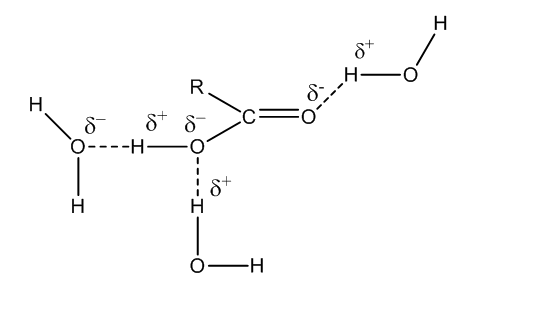
Lower members of aliphatic carboxylic acid are soluble in water. This is due to
(a)Water is non electrolyte
(b)due to London forces
(c)formation of hydrogen bonds with water
(d)van der-waals interaction with water molecules
Answer
139.5k+ views
Hint: An organic acid is an organic compound which contains carboxylic groups. Their general formula is R-COOH. Where R represents any alkyl or phenyl group. Polarity means when a high electronegative atom pulls the electron density of a lesser electronegative atom leading to the formation of partial negative and positive charge on them.
Complete step by step solution:
-Acids that have a general formula R-COOH are organic acids, where R represents any organic chain. The OH (hydroxyl group) is polar in organic acids. This leads to polarity in organic acid. The OH being partial negative charge and C of COOH has partial positive charge. Two poles are formed. These polar groups can now form hydrogen bonding with the water molecules easily. This is only in the case of lower carboxylic acids. In case of higher carboxylic acids, the organic chain R increases, this decreases the polarity of the compound, thus it solubility decreases.
-Carboxylic acids up to four carbon atoms can mix with water in any proportion. When you mix them, the energy released during the formation of new bonds is almost the same as the energy required to break the hydrogen bonds in the pure liquid.
-The solubility of organic acids decreases rapidly with its increase in size. The longer hydrocarbon chair, ‘tails’ comes in between the water molecules and breaks the hydrogen bond, that is, it does not allow the formation of hydrogen bonds. The broken hydrogen bonds are replaced by weaker van der-waals forces dispersion forces.
-Energetics of soluble carboxylic acids are very complex.
Let us consider RCOOH and how it forms hydrogen bonds.

Therefore, the correct answer for the question is option (c).
Note: It is due to the presence of a polar OH group which has the ability to form hydrogen bonds with water molecules, lower carboxylic acids are soluble. Even in higher organic acids, the COOH group has polarity, but their R will be very long chain, preventing them from the formation of hydrogen bonds.
Complete step by step solution:
-Acids that have a general formula R-COOH are organic acids, where R represents any organic chain. The OH (hydroxyl group) is polar in organic acids. This leads to polarity in organic acid. The OH being partial negative charge and C of COOH has partial positive charge. Two poles are formed. These polar groups can now form hydrogen bonding with the water molecules easily. This is only in the case of lower carboxylic acids. In case of higher carboxylic acids, the organic chain R increases, this decreases the polarity of the compound, thus it solubility decreases.
-Carboxylic acids up to four carbon atoms can mix with water in any proportion. When you mix them, the energy released during the formation of new bonds is almost the same as the energy required to break the hydrogen bonds in the pure liquid.
-The solubility of organic acids decreases rapidly with its increase in size. The longer hydrocarbon chair, ‘tails’ comes in between the water molecules and breaks the hydrogen bond, that is, it does not allow the formation of hydrogen bonds. The broken hydrogen bonds are replaced by weaker van der-waals forces dispersion forces.
-Energetics of soluble carboxylic acids are very complex.
Let us consider RCOOH and how it forms hydrogen bonds.

Therefore, the correct answer for the question is option (c).
Note: It is due to the presence of a polar OH group which has the ability to form hydrogen bonds with water molecules, lower carboxylic acids are soluble. Even in higher organic acids, the COOH group has polarity, but their R will be very long chain, preventing them from the formation of hydrogen bonds.
Recently Updated Pages
JEE Main 2025 April 2 Shift 1 Paper Analysis, Answer Key and Student Reactions

JEE Main 2025 April 2 Shift 1 Maths Paper with Answers & Analysis

JEE Mains 2025 April 2 Shift 1 Question Paper with Answer Key - Physics

JEE Main 2025 April 2 Shift 1 Chemistry Paper with Answers - Detailed Analysis

Top Benefits of Vedantu's Online JEE Coaching for Success

Vedantu JEE Offline Coaching Fees & Discounts – Complete Details

Trending doubts
JEE Main 2025 Session 2: Application Form (Out), Exam Dates (Released), Eligibility, & More

JEE Main 2025: Derivation of Equation of Trajectory in Physics

JEE Main Exam Marking Scheme: Detailed Breakdown of Marks and Negative Marking

Learn About Angle Of Deviation In Prism: JEE Main Physics 2025

Number of sigma and pi bonds in C2 molecule isare A class 11 chemistry JEE_Main

Electric Field Due to Uniformly Charged Ring for JEE Main 2025 - Formula and Derivation

Other Pages
NCERT Solutions for Class 11 Chemistry Chapter 9 Hydrocarbons

NCERT Solutions for Class 11 Chemistry Chapter 7 Redox Reaction

JEE Advanced Marks vs Ranks 2025: Understanding Category-wise Qualifying Marks and Previous Year Cut-offs

NCERT Solutions for Class 11 Chemistry Chapter 5 Thermodynamics

Hydrocarbons Class 11 Notes: CBSE Chemistry Chapter 9

NCERT Solutions for Class 11 Chemistry In Hindi Chapter 1 Some Basic Concepts of Chemistry




